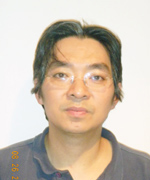Colleagues: Recently Tenured
Leonardo Belluscio, Ph.D., NINDS
Senior Investigator, Developmental Neural Plasticity Section

Education: Manhattan College, Riverdale, N.Y. (B.S. in biology); Columbia University, New York (Ph.D. in neuroscience)
Training: Postdoctoral training in the molecular and functional basis of olfaction at Duke University Medical Center (Durham, N.C.)
Came to NIH: In 2002
Outside interests: Cooking; camping; taking photographs; spending time with family
Research interests: We are studying the mammalian olfactory system to understand neural plasticity and nerve regeneration in the brain. The olfactory system is always rewiring itself: Nasal epithelium cells, which are responsible for odor detection, are continuously regenerating from stem cells in the nose and forming new connections in the brain. This rewiring process provides a window into the development of the olfactory system and offers clues to the interdependence of an olfactory sensory neuron’s molecular function and its effects on neural circuitry.
In particular, we are looking at olfactory neural circuits that exhibit activity-dependent changes in connectivity. Each olfactory sensory neuron expresses one odorant receptor—out of more than 1,000 possibilities—that detects specific odor molecules. The type of receptor determines where the neuron projects its axons on the olfactory bulb (an area of the brain that processes odor information). But changing a neuron’s olfactory receptor causes the neuron to project its axons to a different part of the olfactory bulb. We have shown that neural activity elicited by odor stimulation can alter the refinement of those axonal projections and also affect the organization of subsequent connections deeper in the olfactory bulb.
Through our work, we are trying to understand the relationship between neural plasticity and the nerve’s capacity for repair. We use genetically engineered mice and rely on a multidisciplinary approach that involves biochemistry, molecular biology, and electrophysiological techniques, as well as in vivo imaging and optogenetic and behavioral techniques. Given the connection between olfactory dysfunction and neurological diseases such as Alzheimer disease and Parkinson disease, our work also maintains a strong translational focus.
Huaibin Cai, Ph.D., NIA
Senior Investigator; Head, Transgenics Section, Laboratory of Neurogenetics

Education: Peking University, Beijing, China (B.S. in biology); The Johns Hopkins University School of Medicine, Baltimore (Ph.D. in neuroscience)
Training: Postdoctoral training in the Division of Neuropathology, Department of Pathology, at The Johns Hopkins University School of Medicine
Before coming to NIH: Research associate in the Division of Neuropathology, Department of Pathology, The Johns Hopkins University School of Medicine
Came to NIH: In 2003
Selected professional activities: Editorial boards of Molecular Brain and PLoS ONE
Outside interests: Being a “soccer dad”; hiking and biking with family; running; playing golf
Research interests: I and my lab are interested in figuring out the cause of and developing a treatment for Parkinson disease (PD). PD, the most common degenerative movement disorder, affects millions of people worldwide and there is no cure. The symptoms—resting tremor, rigidity, slow movement, and postural instability—are caused by the degeneration of midbrain dopaminergic neurons. We are using a combination of in vivo mouse genetics and in vitro molecular and cell biology approaches to investigate the molecular participants in the disease processes and explore the underlying pathogenic mechanisms.
We are studying the two most prominent genetic factors in PD—the gene for alpha-synuclein (SNCA) and the gene for leucine-rich repeat kinase 2 (LRRK2). Until now there has been no effective mouse model to help us study the pathology of dopaminergic neurodegeneration. Recently, however, we generated a new line of SNCA transgenic mice that developed profound motor disabilities and the progressive dopaminergic neurodegeneration found in PD.
We are collaborating with other laboratories at NIH and elsewhere to explore the pathogenic processes of synuclein and LRRK2 in the degeneration of dopaminergic neurons. We hope our findings will eventually reveal the cause of PD and lead to the cure for the disease.
Wanjun Chen, M.D., NIDCR
Senior Investigator; Chief, Mucosal Immunology Section

Education: Shandong Medical University and Shandong Academy of Medical Sciences, Shandong, China (M.S. in microbiology and immunology); Qingdao University Medical School, Qingdao, China (M.D.)
Training: Internship in medicine at Qingdao Municipal Hospital (Qingdao, China); postdoctoral training in immunology at Harvard Medical School (Boston)
Came to NIH: In 1997
Selected professional activities: Co-organizer, Keystone Symposium, “TGF-beta in Immune Responses: From Bench to Bedside, 2011”
Outside interests: Swimming; listening to music; gardening
Research interests: The mucosal immune system protects the mucous membrane—a protective lining of the respiratory, digestive, and urogenital tracts and other structures—against potentially harmful microbes and foreign antigens. Understanding that system is instrumental for developing strategies such as mucosal vaccination against infectious agents and therapies for allergy, inflammation, and autoimmune diseases.
Not all foreign antigens are pathogens, however; more than 100 kilograms of food antigens are processed each year by our gastrointestinal mucosa. The gut immune system has to differentiate between beneficial dietary antigens and noxious or infectious pathogens. Failure to tolerate dietary antigens may lead to intestinal hypersensitivity such as food-sensitive enteropathies (diseases of the intestinal tract); failure to expel infectious pathogens may contribute to disease.
During the complex and well-orchestrated immune responses in the mucosal system, T cells play a pivotal role in both immunity and tolerance. Many cytokines and factors influence mucosal T-cell immunity and tolerance with Transforming growth factor–beta (TGF-beta) being perhaps the most important. I and my lab are elucidating the mechanisms by which TGF-beta regulates T-cell immunity and tolerance. We are also manipulating T-cell immunity versus tolerance in animal models. We hope to understand the pathogenesis of autoimmunity and inflammation, cancer, and infectious diseases and to develop potential therapies for relevant human diseases.
James Gulley, M.D., Ph.D., NCI-CCR
Senior Investigator; Head, Clinical Trials Group; Deputy Chief, Laboratory of Tumor Immunology and Biology; attending physician, Clinical Center

Education: Southern Adventist University, Collegedale, Tenn. (B.A. in chemistry); Loma Linda University, Loma Linda, Calif. (M.D. and Ph.D. in microbiology)
Training: Residency in internal medicine at Emory University (Atlanta); fellowship in medical oncology at NCI
Came to NIH: In 1998 for training; joined staff in 2001
Selected professional activities: Winner of the 2010 Presidential Early Career Award for Scientists and Engineers; staff physician, Walter Reed National Military Medical Center (Bethesda, Md.)
Outside interests: Kayaking; sailing; mountain biking; spending time with family
Research interests: The Laboratory of Tumor Immunology and Biology (LTIB) conducts translational research in tumor immunology, immunotherapy, mechanisms of tumor cell–immune cell interactions, and immune mechanisms. My clinical group takes promising findings in the lab and tests them in clinical trials both within the NIH Clinical Center and in other NCI-funded cancer centers and cooperating groups.
One vaccine developed within the LTIB is PSA-TRICOM for prostate cancer. Initial clinical studies led to two concurrent phase 2 studies in patients with metastatic prostate cancer. A trial at NCI demonstrated evidence of immune responses (better immune responses correlated with improved overall survival), and a multicenter randomized controlled trial showed a 44 percent reduction in the mortality rate for patients receiving the vaccine versus a placebo and an 8.5 month improvement in median overall survival. Based on these results, I am leading a global randomized controlled phase 3 study of PSA-TRICOM.
The LTIB is also studying brachyury, a transcription factor that is involved in epithelial to mesenchymal transition (a process important in embryogenesis and organ development in which epithelial cells change into less ordered, more varied, and more mobile mesenchymal cells). We have shown that brachyury is overexpressed in tumors compared with normal tissue and is associated with “stemness” and drug resistance. We have developed a vaccine that targets brachyury that is scheduled to enter a first-in-human trial.
Matthew Hoffman, B.D.S., Ph.D., NIDCR
Senior Investigator; Chief, Matrix and Morphogenesis Section, Laboratory of Cell and Developmental Biology

Education: University of Otago School of Dentistry, Dunedin, New Zealand (B.D.S.); University of Rochester School of Medicine and Dentistry, Rochester, N.Y. (M.S. and Ph.D. in microbiology and immunology)
Training: Visiting fellow in NIDCR’s Cell Biology Section
Came to NIH: In 1994 for training; became staff scientist in 2000 and chief of Matrix and Morphogenesis Unit in 2004
Selected professional activities: Organized Gordon Research Conference on Salivary Glands and Exocrine Biology in 2009, was vice chair in 2009 and chair in 2011
Outside interests: Swimming with the DC Aquatics Club, a masters swim team; running and biking; hiking in the mountains; cooking; wine tasting
Research interests: My lab studies how salivary glands develop from the earliest stages of cell commitment, progenitor-cell maintenance, and differentiation; to growth and morphogenesis; to the formation of a functional gland. Elucidating how cells are directed along a series of cell-fate decisions is critical for understanding organogenesis and provides a template for future regenerative therapy. We are developing strategies to regenerate adult salivary tissue that has been damaged by radiation treatment for head and neck cancer, trauma, or diseases such as the autoimmune disorder Sjögren syndrome.
By understanding how salivary glands develop during embryogenesis, we can develop regenerative strategies for repairing damaged adult tissue. We focus on the roles of growth factors and the extracellular matrix, characterize stem cells in the gland and how they function, and investigate the genetic regulation of branching morphogenesis. We also explore interactions among the various cell types in salivary glands—including epithelial and neuronal cells—as well as blood vessels and mesenchymal cells. We want to understand how these cells contribute to the local cellular microenvironment, or “niche,” of salivary progenitor cells. We are identifying changes that occur in the stem cell niche during damage to the glands. We hope our findings will help us use progenitor cells to repair or regenerate damaged adult tissue.
Andrew Holmes, Ph.D., NIAAA
Principal Investigator; Chief, Laboratory of Behavioral and Genomic Neuroscience, Section on Behavioral Science and Genetics

Education: University of Newcastle upon Tyne (now Newcastle University), Newcastle upon Tyne, U.K. (B.A. in psychology); University of Leeds, Leeds, U.K. (Ph.D. in behavioral pharmacology)
Training: Postdoctoral training in behavioral neuroscience at NIMH
Came to NIH: In 1999 for training; became tenure-track investigator in 2003
Selected professional activities: Editor-in-chief of Genes, Brain, and Behavior
Outside interests: Bird watching
Research interests: My principal area of research interest is studying how stress affects the risk for developing neuropsychiatric disorders and addictions. My lab and I are using animal models to determine how exposure to stress and drugs of abuse affect an individual’s capacity for high-level cognitive and executive functions. Executive functions include the ability to inhibit inappropriate behaviors such as aggression and excessive fear and the capacity for controlling and avoiding potentially self-destructive activities as often occurs in drug and alcohol addiction.
One goal of this research is to uncover the genes that increase a person’s susceptibility to these detrimental effects of stress in order to identify individuals who are particularly at risk. We are also trying to elucidate the neural systems and molecules that are compromised by stress as a first step in developing new medications for stress-related neuropsychiatric diseases ranging from post-traumatic stress disorder to alcoholism.
Richard J. Krauzlis, Ph.D., NEI
Senior Investigator; Chief, Eye Movements and Visual Selection Section, Laboratory of Sensorimotor Research

Education: Princeton University, Princeton, N.J. (A.B. in biology); University of California at San Francisco (Ph.D. in neuroscience)
Training: Postdoctoral training in NEI’s Laboratory of Sensorimotor Research
Before coming to NIH: Professor, Systems Neurobiology Laboratory at the Salk Institute for Biological Studies (La Jolla, Calif.)
Came to NIH: In 1991–1997 for training; returned in 2011 as senior investigator
Selected professional activities: Serves on editorial boards for Journal of Neuroscience and Journal of Vision; senior editor for Vision Research
Outside interests: Exploring art and history; painting; running; spending time with wife and two sons
Research interests: My lab uses a variety of techniques to manipulate and monitor neural activity to understand the brain mechanisms that link motor control to sensory and cognitive processing. My previous work has covered pursuit (following a moving target) and saccadic (jerky) eye movements; physiological studies of the cerebellum and cerebral cortex; psychophysical studies of visual motion perception and visual attention; and computational modeling of eye movements.
While I was at the Salk Institute, my lab determined that the superior colliculus—a structure on the roof of the midbrain best known for its role in the motor control of orienting movements—contains a priority “map” that keeps track of behaviorally relevant objects in the visual field. Activity in this map is important for deciding where and when to look, but we demonstrated that it also plays a crucial role in the control of spatial attention (the ability to select only the relevant bits of information for perception and action). Although this higher-order function is normally associated with areas in the cerebral cortex, our findings raise the possibility that it is built on top of older brain systems rather than developed de novo. Determining how these cortical and subcortical systems interact will be a focus of the work in my lab at NIH.
C. Ola Landgren. M.D., Ph.D., NCI-CCR
Senior Investigator; Chief, Multiple Myeloma Section, Metabolism Branch

Education: Lund University, Lund, Sweden (B.A. in medicine); Karolinska Institute, Stockholm, Sweden (M.D. and Ph.D. focusing on diagnostics and prognostics of Hodgkin lymphoma)
Training: Residency in hematology and internal medicine at Karolinska University Hospital (Stockholm, Sweden)
Before coming to NIH: Attending physician and clinical researcher (lymphoproliferative malignancies and related precursors) at Karolinska University Hospital
Came to NIH: In 2004 as a visiting fellow and later as a research fellow in NCI-DCEG; in 2009 joined NCI-CCR as a principal investigator
Selected professional activities: Editorial boards for Haematologica and Leukemia and Lymphoma
Outside interests: Traveling; listening to music; socializing
Research interests: My major research interests are in the treatment, causation, diagnostics and prognostics, and natural history of multiple myeloma and its precursor states—monoclonal gammopathy of undetermined significance and smoldering (slow-growing) myeloma. I also study related hematologic malignancies and their precursor states including chronic lymphocytic leukemia and monoclonal B-cell lymphocytosis. I focus on the treatment-, host-, disease-, and immune-related factors in the pathway from precursor to full-blown malignancy.
I am also examining novel therapies for multiple myeloma and its precursor states; identifying predictors for progression from precursor to malignancy and outcome; defining roles for infectious antigens, inflammation, chronic immune stimulation, and immune modulation in hematopoietic carcinogenesis; and assessing and defining host- and disease-related diagnostic and prognostic markers.
My lab recently generated data—using advanced imaging and molecular profiling—that suggest that a fraction of the patients diagnosed with smoldering myeloma actually have early myeloma. We are now developing treatment trials for early myeloma patients. Our ultimate goal is to eliminate evidence of minimal residual disease. By treating these patients with highly effective therapies and carefully monitoring them, we hope we are laying the groundwork for a cure for myeloma.
Yikang Rong, Ph.D., NCI-CCR
Senior Investigator and Head, Eukaryotic Genome Maintenance Unit, Laboratory of Biochemistry and Molecular Biology

Education: University of Science and Technology of China, Hefei, Anhui, China (B.S. in biology); University of Utah, Salt Lake City (Ph.D. in genetics)
Training: Postdoctoral training at the University of Utah
Came to NIH: In January 2002
Outside interests: Playing video games
Research interests: Although the fruit fly Drosophila melanogaster is one of the best model organisms for genetic research, we have lacked the tools for targeting specific genes for mutation by homologous recombination. For more than 20 years, yeast and mouse researchers have been able to use gene targeting to introduce specific mutations into almost any gene. I helped develop gene-targeting methods in D. melanogaster to allow researchers worldwide to mutate many different loci that were not previously identified in traditional mutant screens. My group is interested in studying the mechanisms for DNA double-strand break (DSB) repair in D. melanogaster. I have introduced a site-specific DSB system in which one can control the position, number, and timing of DNA breaks as well as the surrounding genomic environment. We have found that the genomic structure around the DNA break dictates the repair mechanism and template.
My lab is also studying cellular response to DNA damage. For example, a eukaryotic cell responds by stopping the progression of various cell-cycle programs to ensure proper repair of the damage or by inducing cell death so that irreparably damaged cells can be eliminated. These responses are partly controlled by the p53 tumor suppressor, the ataxia telangiectasia mutated (ATM) checkpoint kinase, and the Mre11 protein complex. We have generated knockout mutants of p53, ATM, and members of the Mre11 complex and are characterizing the mutant phenotypes. Our work will contribute to a better understanding of how eukaryotic organisms maintain the physical integrity of their genomes and shed light on how genome instability could give rise to human cancers.
Anne Summer, M.D., NIDDK
Senior Investigator; Chief, Ethnicity and Health Section, Diabetes, Obesity, and Endocrinology Branch

Education: Brown University, Providence, R.I. (B.A. in English literature); University of Pennsylvania School of Medicine, Philadelphia (M.D.)
Training: Residency in internal medicine at Reading Hospital and Medical Center (Reading, Pa.); fellowship in nutrition and metabolism at the Hospital of the University of Pennsylvania (Philadelphia); fellowship in endocrinology, diabetes, and metabolism at the Medical College of Pennsylvania (Philadelphia)
Before coming to NIH: Assistant professor of medicine, assistant professor of biochemistry, and attending physician at Allegheny University of the Health Sciences (Philadelphia); attending physician and chief of the Lipid Clinic and the Hypertension Clinic at the Philadelphia VA Medical Center (Philadelphia)
Came to NIH: In 1998
Selected professional activities: Serves on Board of Governors of the Association of Black Cardiologists; member of the American Heart Association Science Committee on Diabetes and Council on Nutrition, Physical Activity, and Metabolism; serves on the editorial boards of Journal of Clinical Endocrinology and Metabolism, Obesity, and Ethnicity and Disease; serves on Senior Advisory Council of Global Heart
Outside interests: 18th- and 19th-century American history, especially the Underground Railroad and the canal system
Research interests: I do epidemiologic and metabolic research on racial differences in cardiometabolic disorders—especially obesity, diabetes, and heart disease—that focuses on people of African descent. My work has shown certain cardiovascular risk factors do not translate across races. For example, I and my lab found that the current guidelines used to predict insulin resistance—such as central obesity and ratio of triglyceride level to high-density lipoprotein cholesterol level—are inaccurate for blacks.
By understanding the relationship between insulin resistance and glucose and lipid metabolism in blacks, we hope to identify the pathways that lead to cardiometabolic disease. Then improved screening tests and more effective interventions can be developed, and the medical and social costs that communities and individuals experience as a result of the high prevalence and chronicity of cardiometabolic diseases can be minimized.
Our studies are designed to examine the combined importance of metabolism, diet, exercise, living conditions, and education on disease development and outcomes. Although our research is focused on African-Americans and Africans living in the United States, we are collaborating with investigators in Africa and the Caribbean to expand our studies. We will also be considering the role of genetic background.
The public health implications of racial differences in disease risk factors are profound. African-Americans on average falsely appear to be at lower risk of cardiovascular disease and type 2 diabetes and thus may not be appropriately screened, diagnosed, and treated.
This page was last updated on Monday, May 2, 2022
